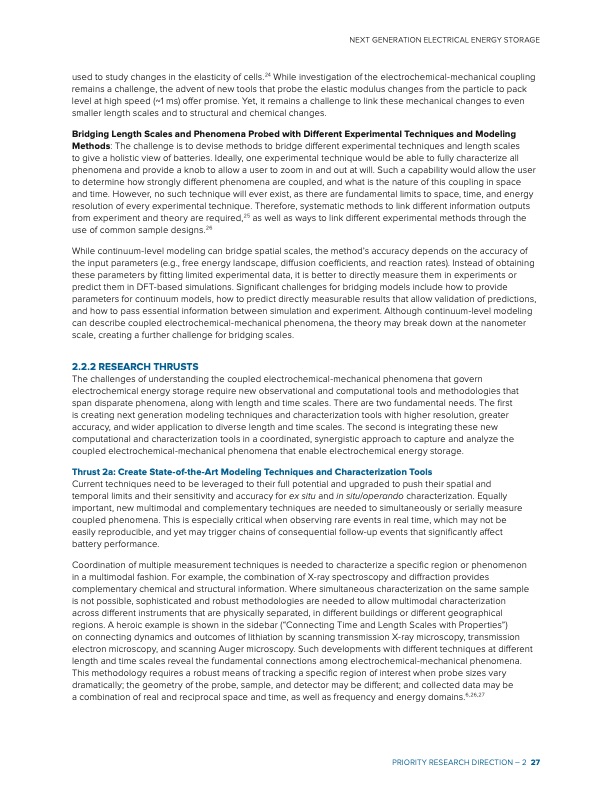
PDF Publication Title:
Text from PDF Page: 033
used to study changes in the elasticity of cells.24 While investigation of the electrochemical-mechanical coupling remains a challenge, the advent of new tools that probe the elastic modulus changes from the particle to pack level at high speed (~1 ms) offer promise. Yet, it remains a challenge to link these mechanical changes to even smaller length scales and to structural and chemical changes. Bridging Length Scales and Phenomena Probed with Different Experimental Techniques and Modeling Methods: The challenge is to devise methods to bridge different experimental techniques and length scales to give a holistic view of batteries. Ideally, one experimental technique would be able to fully characterize all phenomena and provide a knob to allow a user to zoom in and out at will. Such a capability would allow the user to determine how strongly different phenomena are coupled, and what is the nature of this coupling in space and time. However, no such technique will ever exist, as there are fundamental limits to space, time, and energy resolution of every experimental technique. Therefore, systematic methods to link different information outputs from experiment and theory are required,25 as well as ways to link different experimental methods through the use of common sample designs.26 While continuum-level modeling can bridge spatial scales, the method’s accuracy depends on the accuracy of the input parameters (e.g., free energy landscape, diffusion coefficients, and reaction rates). Instead of obtaining these parameters by fitting limited experimental data, it is better to directly measure them in experiments or predict them in DFT-based simulations. Significant challenges for bridging models include how to provide parameters for continuum models, how to predict directly measurable results that allow validation of predictions, and how to pass essential information between simulation and experiment. Although continuum-level modeling can describe coupled electrochemical-mechanical phenomena, the theory may break down at the nanometer scale, creating a further challenge for bridging scales. 2.2.2 RESEARCH THRUSTS The challenges of understanding the coupled electrochemical-mechanical phenomena that govern electrochemical energy storage require new observational and computational tools and methodologies that span disparate phenomena, along with length and time scales. There are two fundamental needs. The first is creating next generation modeling techniques and characterization tools with higher resolution, greater accuracy, and wider application to diverse length and time scales. The second is integrating these new computational and characterization tools in a coordinated, synergistic approach to capture and analyze the coupled electrochemical-mechanical phenomena that enable electrochemical energy storage. Thrust 2a: Create State-of-the-Art Modeling Techniques and Characterization Tools Current techniques need to be leveraged to their full potential and upgraded to push their spatial and temporal limits and their sensitivity and accuracy for ex situ and in situ/operando characterization. Equally important, new multimodal and complementary techniques are needed to simultaneously or serially measure coupled phenomena. This is especially critical when observing rare events in real time, which may not be easily reproducible, and yet may trigger chains of consequential follow-up events that significantly affect battery performance. Coordination of multiple measurement techniques is needed to characterize a specific region or phenomenon in a multimodal fashion. For example, the combination of X-ray spectroscopy and diffraction provides complementary chemical and structural information. Where simultaneous characterization on the same sample is not possible, sophisticated and robust methodologies are needed to allow multimodal characterization across different instruments that are physically separated, in different buildings or different geographical regions. A heroic example is shown in the sidebar (“Connecting Time and Length Scales with Properties”) on connecting dynamics and outcomes of lithiation by scanning transmission X-ray microscopy, transmission electron microscopy, and scanning Auger microscopy. Such developments with different techniques at different length and time scales reveal the fundamental connections among electrochemical-mechanical phenomena. This methodology requires a robust means of tracking a specific region of interest when probe sizes vary dramatically; the geometry of the probe, sample, and detector may be different; and collected data may be a combination of real and reciprocal space and time, as well as frequency and energy domains.6,26,27 NEXT GENERATION ELECTRICAL ENERGY STORAGE PRIORITY RESEARCH DIRECTION – 2 27PDF Image | Next Generation Electrical Energy Storage

PDF Search Title:
Next Generation Electrical Energy StorageOriginal File Name Searched:
BRN-NGEES_rpt-low-res.pdfDIY PDF Search: Google It | Yahoo | Bing
Sulfur Deposition on Carbon Nanofibers using Supercritical CO2 Sulfur Deposition on Carbon Nanofibers using Supercritical CO2. Gamma sulfur also known as mother of pearl sulfur and nacreous sulfur... More Info
CO2 Organic Rankine Cycle Experimenter Platform The supercritical CO2 phase change system is both a heat pump and organic rankine cycle which can be used for those purposes and as a supercritical extractor for advanced subcritical and supercritical extraction technology. Uses include producing nanoparticles, precious metal CO2 extraction, lithium battery recycling, and other applications... More Info
| CONTACT TEL: 608-238-6001 Email: greg@infinityturbine.com | RSS | AMP |